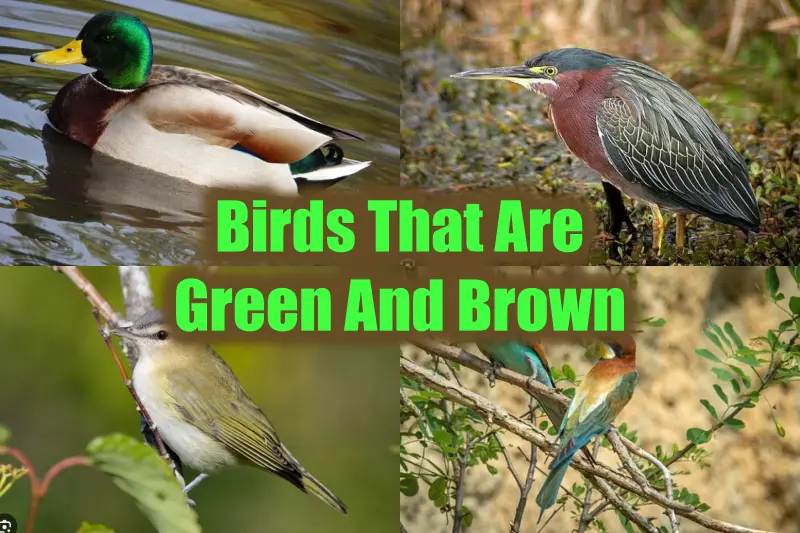When contemplating the combination of green and brown colors, the first image that comes to mind is a beautiful, lush tree. But have you ever wondered if there are any green and brown birds perched on those trees?
To clear out the hazy cloud of confusion in my mind and yours, I’ve compiled a comprehensive list of 10 birds that exhibit green and brown hues, complete with pictures and their respective geographic locations.
10 Birds That Are Green And Brown
1) Wild Duck
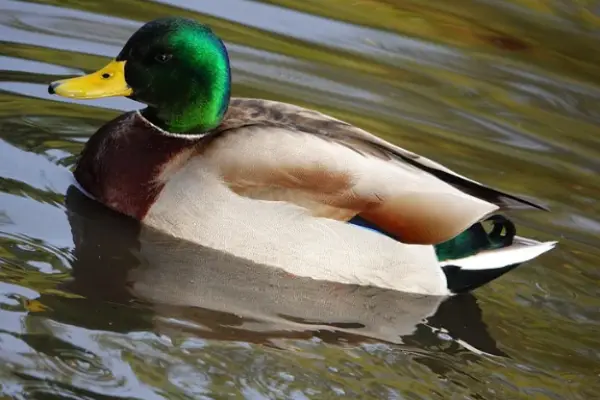
| Scientific Name | Anas platyrhynchos |
| Size | 50–65 cm and a wingspan of 81–98 cm |
| Identification | Males have a distinctive glossy green head, while females boast mainly brown-speckled bodies. |
| Geographic Location | Widely distributed across the Northern and Southern Hemispheres |
The male wild duck or mallard sports a glossy bottle-green head, complemented by a stylish white collar that separates it from a purple-tinged brown chest.
They are social animals, preferring to hang out in groups or flocks of varying sizes in wetlands across America, Eurasia, and North Africa.
The female lays 8 to 13 creamy white to greenish-buff eggs, and once the ducklings hatch, they’re ready to swim almost immediately.
2) Green-tailed towhee
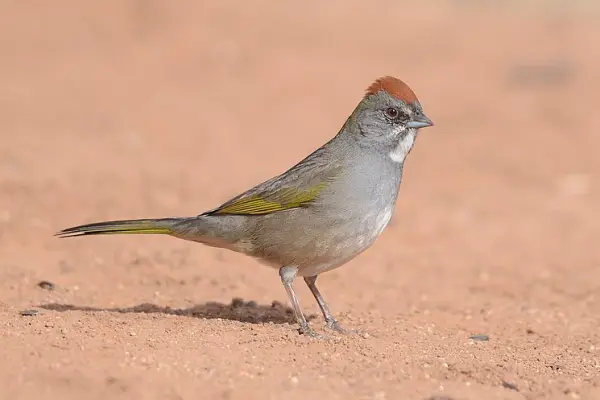
| Scientific Name | Pipilo chlorurus |
| Size | Measures 7.25 inches long and weighs 29 g. |
| Identification | Known for its deep olive and yellow-green wing stripes, white throat, and rufous crown, Males also sport bright reddish-brown crowns. |
| Geographic Location | The United States of America |
The green-tailed towhee has deep olive and yellow-green wing stripes.
They might be fairly tame, but they know how to keep a low profile under the bushes.
Male Green-tailed Towhee spends long hours perched at the top of shrubs, belting out tunes to impress the females.
When danger approaches, the female green-tailed towhee is seen slipping off the nest and running with her tail raised.
Interestingly, the oldest known individual boasts an impressive age of at least 7 years and 8 months.
3) Green Heron

| Scientific Name | Butorides virescens |
| Size | Adult body length is about 44 cm with a wingspan of 25.2–26.8 in |
| Identification | Greenish-black cap, greenish back and wings, a chestnut neck with a white line, and short yellow legs. |
| Geographic Location | Found in North and Central America |
The Green Heron is a nocturnal bird with a glossy greenish-black cap and a beautiful dark violet-brown neck.
It is a very skilled and sly hunter, using bread crusts or insects as bait to lure in fish.
Green Herons are family-oriented, forming pairs during an intense courtship display.
They select nesting sites, build cozy nests of sticks, and take turns incubating pale green eggs.
4) Green-winged teal
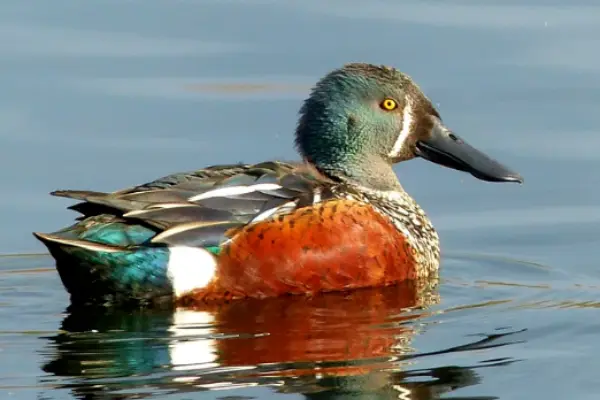
| Scientific Name | Anas carolinensis |
| Size | Ranging from 12.2 to 15.3 inches in length with a wingspan of 20.5–23.2 inches |
| Identification | Breeding males have a grey flank, a chestnut head, and a distinctive white-edged green speculum |
| Geographic Location | North America except for the Aleutian Islands |
The American Teal is found wintering far south of its breeding grounds in Northern America.
As the smallest North American dabbling duck, the male American Teal rocks a sleek look with grey flanks, a chestnut head, and a touch of yellow at the rear end.
They arrive at nesting areas right when the snow melts and are among the earliest spring migrants.
These ducks seek food on mud flats and look for small seeds, stems, and leaves of aquatic vegetation.
Green-winged teals nest on the ground, concealed in heavy grass or brushy covers.
5) Violet-Green Swallow
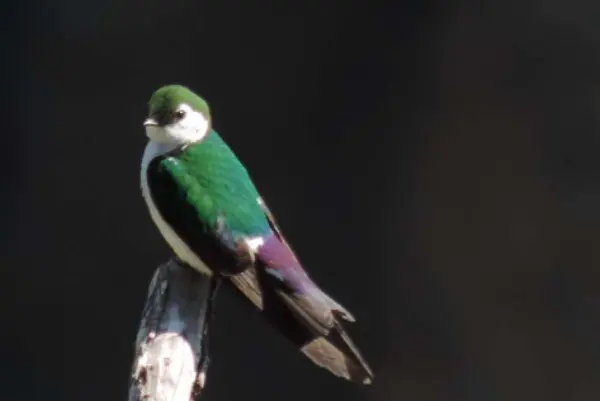
| Scientific Name | Tachycineta thalassina |
| Size | Average body length of 13 cm |
| Identification | It has a glossy green head, purple hints on the nape, rump, and upper tail, and unique white rump side patches. |
| Geographic Location | North America |
The violet-green swallow has a glossy green head, hints of purple flair, and white patches on its rump.
They are secondary cavity nesters, turning tree holes or cliff cracks into cozy homes.
It also showcases a certain degree of sexual dimorphism in terms of its body color; the males sport brighter colors than the females, with an extra touch of green on their heads.
They are often seen feeding on ants, beetles, and even the occasional spider.
6) Elegant Trogon
| Scientific Name | Trogon elegans |
| Size | They are around 28–30 centimeters in length and weigh around 60–78 grams |
| Identification | The males have a red-orange, metallic green, and white chest band, while the females and young males have a brownish-grey with a white eye ring. |
| Geographic Location | Found in Central America |
The male elegant trogon has a vibrant red-orange, metallic green, and a touch of white coloration on its body.
Females and young males, on the other hand, while still beautiful, opt for a more subtle, brownish-grey fur.
Tail movements serve as their avian language, conveying dominance and aggression or even signaling predators to back off.
They give a lot of importance to parenting, with both parents sharing the responsibilities, from incubation to feeding.
The trogons are omnivores with a diet of grapes, cherries, and a gourmet selection of insects like grasshoppers and moths.
7) Yellow-Green Vireo
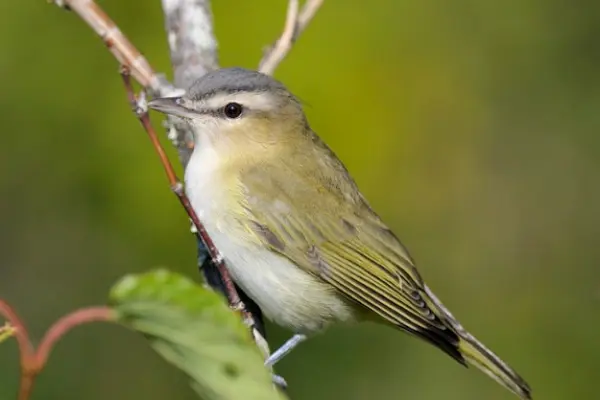
| Scientific Name | Vireo flavoviridis |
| Size | It measures 14–14.7 cm in length and weighs around 18.5 g. |
| Identification | It has olive-green upperparts, yellow breast sides, and a distinctive dark line from the bill to red-brown eyes. |
| Geographic Location | The United States of America |
The yellow-green vireo migrates all the way from Mexico to Panama for the summer, then moves to the northern Andes and the western Amazon Basin for the winter.
It has a sleek gray crown, a stylish dark line from the bill to red-brown eyes, and a bit of white on its supercilium.
The female builds a cozy cup nest using a mix of plant materials, placing it strategically in a tree branch.
It also releases a nasal “nyaaah” call and a repetitive song that goes veree veer viree, fee’er vireo viree as a means of communication.
8) Calliope Hummingbird

| Scientific Name | Selasphorus calliope |
| Size | It measures 7–10 cm in length, spans 11 cm across the wings |
| Identification | It has a glossy green hue on the back and wine-red streaks on the neck |
| Geographic Location | Native to the United States and Canada. |
The calliope hummingbird is the smallest bird in the United States and Canada, and despite its small size, it’s known for flying across America.
The male calliope hummingbird has a brighter appearance than the females, with glossy green and wine-red streaks on its throat.
The female takes charge, building a cozy nest in conifer trees or even alder trees.
Males, on the other hand, claim and defend their territory but don’t stick around for parenting duties.
9) Buff-Bellied Hummingbird
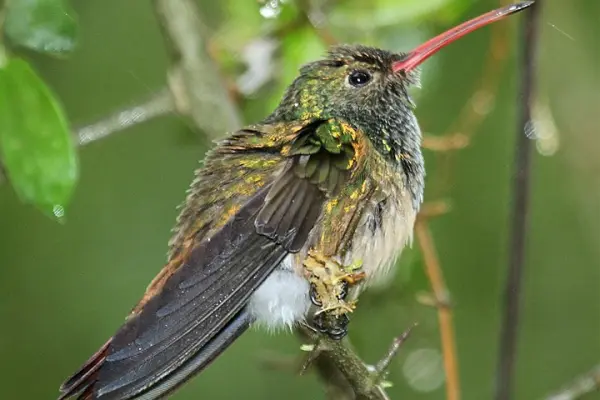
| Scientific Name | Amazilia yucatanensis |
| Size | About 10 to 11 cm in length and around weighing 2.9 to 4.7 g |
| Identification | Adult males boast metallic bronze-green upperparts with bright yellowish emerald green throats while females though similar have a less bright look. |
| Geographic Location | From southern Texas to the Yucatán Peninsula |
The buff-bellied hummingbird is a multi-colored bird with a rosy beak and a green body with a brownish underside.
They are known for zealously defending their territory, be it a flowering shrub or a sugar-water feeder.
Their vocalizations include a distinctive two-syllable “tsi-we” during communications.
10) European Bee-Eater
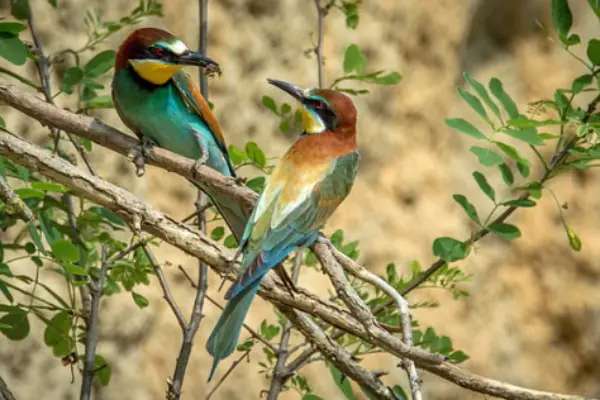
| Scientific Name | Merops apiaster |
| Size | 27–29 cm in length |
| Identification | Brown and yellow upper parts, green wings, and a sleek black beak. |
| Geographic Location | Breeding in southern and central Europe, northern and southern Africa, and western Asia, and wintering in tropical Africa. |
The European bee-eater found in Europe, Africa, and western Asia has brown and yellow upper parts, green wings, and a sleek black beak.
During courtship, the male European bee-eater offers a fine dining experience, presenting larger morsels to the female while enjoying the smaller bites himself.
As its name suggests, it predominantly dines on insects, specializing in bees, wasps, and hornets.
It also skillfully removes the bee’s sting before devouring it.
Conclusion
This brings us to the end of another colorful article on the elegant and beautiful brown and green birds found around the world, along with ways to identify and locate them. These birds not only serve as a beautiful palette in the sky but are also responsible for maintaining balance in the ecosystem.
Keep an eye out for more amazing and interesting articles as we bring forth new content every single day!
Also Read:

Hi everyone, my name is Shawna, and I’ve always been fascinated by the fascinating diversity of flora and fauna that our nature has in it. I am currently studying biotechnology and am particularly interested in animal biotechnology, delving into the intricate processes that define their true nature and uniqueness.
